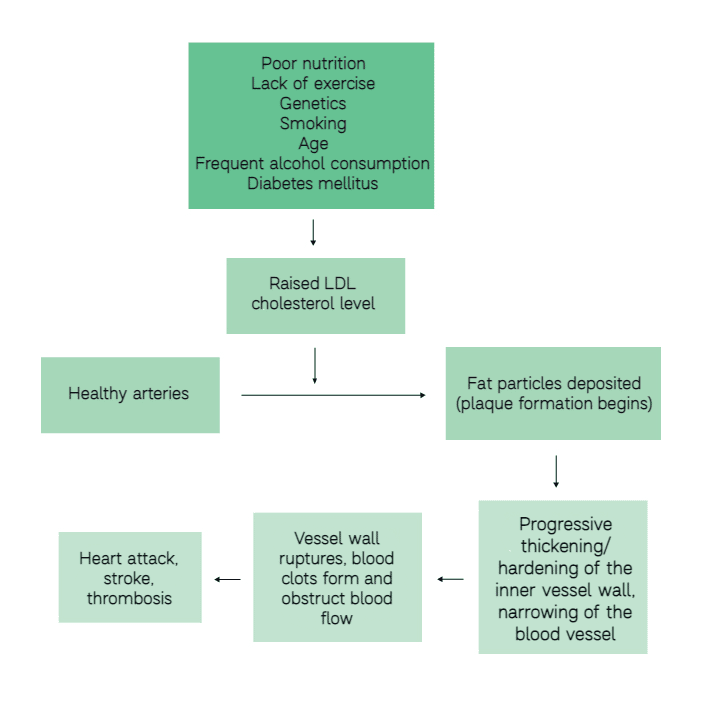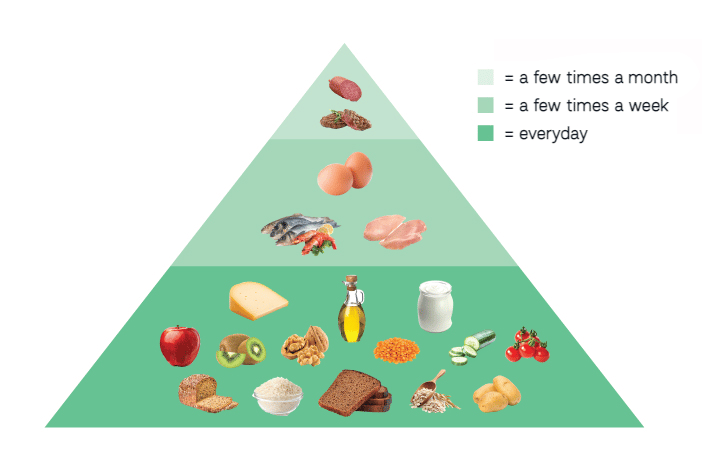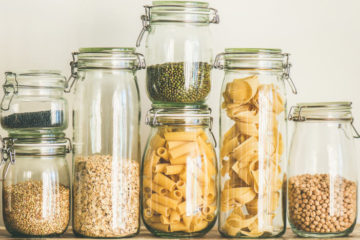Lower cholesterol levels through diet changes – Good and bad cholesterol

- What is cholesterol?
- How much cholesterol should I consume?
- Transportation of cholesterol in the body
- What are cholesterol levels?
- What are the consequences of high cholesterol?
- How can I lower my cholesterol without medication?
- Which foods lower cholesterol?
- Cholesterol: the low-down
- Frequently Asked Questions
Cholesterol has an extremely bad reputation, but it is, in fact, important for the human body. However, elevated cholesterol levels can lead to serious health consequences such as cardiovascular diseases, which happen to be the second most common cause of death in the UK.
In this article we aim to enlighten you on the topic of cholesterol, explain the difference between good and bad cholesterol and provide tips to regain control over your cholesterol levels! You will also learn how Upfit can help you lower your cholesterol levels and body weight to improve your quality of life and reduce the risk of cardiovascular disease.
What is cholesterol?

Cholesterol is a type of fat. Although cholesterol has a less than favourable reputation, it actually plays a very important role in our bodies. Among other things, it serves as an essential building block for body parts such as cell membranes and nerve tracts. In addition, cholesterol is a component in the production of vital substances (e.g. bile acids and vitamin D) and the chemical messengers of our body, such as steroid hormones (e.g. the sex hormones testosterone and oestrogen).
Nevertheless, cholesterol is not one of the vital nutrients which must be obtained via diet. The reason for this is that the body can produce cholesterol by itself, so only about a third of the cholesterol we require is obtained from food. If you consume too much cholesterol in your diet, your body reduces its own production slightly. Despite this, a high-cholesterol diet can still lead to elevated cholesterol levels, as you will learn in the course of the article.
How much cholesterol should I consume?

The National Institute for Health and Clinical Excellence (NICE) recommends a daily intake of 300 mg of cholesterol per day for those at risk of developing coronary heart diseases. However, men exceed this recommendation by an average of 50 mg, while women are about 50 mg below the recommended amount. Some of the cholesterol from food is transported from the intestine to the liver, where it is further metabolised. The remaining cholesterol is subsequently excreted in the stool.
The intestine and liver also produce their own cholesterol. If we consume too much cholesterol via our diet, the body reduces its own production to an extent and inhibits the transport from the intestine to the liver. If, on the other hand, we consume too little cholesterol, the body’s own production increases. Incidentally, cholesterol is found only in animal-derived foods, which is why vegans meet their cholesterol needs 100 % via self-synthesis, i.e. exclusively with the cholesterol produced by the body itself.
On average, men’s cholesterol levels are too high, while women’s are too low.
Transportation of cholesterol in the body

Cholesterol is a fat and is therefore not soluble in water. Our blood, on the other hand, consists almost exclusively of liquid. So that fats and fat-like substances such as cholesterol can still be transported through the body via the bloodstream, they must combine with water-soluble substances. This is where so-called lipoproteins come into play.
You can think of lipoproteins like a ball. The outer layer consists of water-soluble substances such as protein, while water-insoluble fats are stored inside. Depending on the ratio of fat to protein, lipoproteins are divided into five different groups. However, their structure is not rigid, which means that lipoproteins can switch between the five groups. Each lipoprotein group performs specific tasks. We introduce you to the two most important lipoproteins.
LDL cholesterol
The “low density lipoprotein” (LDL) consists of about 80 % fat. LDL transports the cholesterol from the liver to other cells of the body so that it can be further processed there as a building block of important body parts such as cell membranes.
LDL is also referred to as “bad cholesterol”, however. If there is too much LDL in our bodies, the excess cholesterol is stored in the blood vessel walls. This is bad news, as there shouldn’t be any fat deposits in your blood vessels whatsoever. Due to these deposits, the bloodstream becomes narrower and blood flow is restricted. This condition is called atherosclerosis. In the worst case, blood flow is completely blocked and a heart attack or stroke can occur.
HDL cholesterol
HDL cholesterol (high density lipoprotein) is a lipoprotein with a fat content of 50 %. It is also known as “good cholesterol” because it transports excess cholesterol from the body tissues back to the liver. In the liver, the cholesterol is then used in the production of vital substances and chemical messengers, such as hormones, vitamin D and bile acids. Bile acids are then excreted with the bile via the intestine and cholesterol levels are thus lowered.
What are cholesterol levels?

The body’s cholesterol levels are subject to large fluctuations and can, for example in stressful situations, vary by up to 60 %. Similarly, the types and amounts of other nutrients in the diet, as well as age and sex, can affect the concentration of cholesterol in the blood. For example, women up to the age of 55 have lower serum (total) cholesterol levels than older women. You can find out which cholesterol levels are generally considered desirable in the table below.
| Parameter | Cholesterol level |
|---|---|
| Cholesterol | < 200 mg/dL (milligrams per decilitre) |
| HDL cholesterol | > 50 mg/dL |
| LDL cholesterol | < 150 mg/dL |
The so-called “risk index” can be determined using the levels of HDL and LDL cholesterol. This indicates how high the risk is of coronary heart disease such as atherosclerosis or heart attack. The risk index is determined by dividing the LDL-cholesterol value by the HDL-cholesterol value. People who have no other risk factors should aim for a value below 3, while those with existing cardiovascular diseases ought to have a value below 2.5.
Example:
LDL cholesterol = 150 mg/dL; HDL cholesterol = 50 mg/dL
Risk Index calculation = 150 ÷ 50 = 3
This person has a risk index of 3. If they are otherwise healthy, they do not have to worry about cardiovascular disease for the time being, but could slowly take measures to lower the value. However, if the person is predisposed to such diseases, they have a higher risk of developing a cardiovascular disease. In this case, we recommended that you take a look at our nutrition tips for reducing cholesterol, detailed later on in this article.
What are the consequences of high cholesterol?

Cholesterol is very important for the body. However, if levels are too high, there may be repercussions for your health. The risk of arteriosclerosis and thus for diseases such as heart attack or stroke increases with elevated cholesterol levels.
To be precise, LDL cholesterol is the issue here. If we have too much of it, excess is stored in the form of fat particles in the blood vessel wall, mainly in the arteries, which causes a plaque to form. “Plaque” describes the deposits in the inner wall of the blood vessel.
The process is gradual and often goes unnoticed for several years. However, more and more fat accumulates over time, which makes the plaque thicker. As a result, the interior of the vessel narrows and hardens. The veins become narrower and cannot expand to their previous extent, so the body must react accordingly in order to continue to pump enough blood throughout the body.
The pressure in the blood vessel increases and inflammatory processes occur, as a result of which the plaques can rupture. Once they have ruptured, a blood clot forms within a very short time, potentially clogging the artery. Finally, vascular occlusion occurs when the blood clot closes the vein like a cork, as a result of which blood flow is completely obstructed.
Cardiovascular disease is the second most common cause of death in the UK.
Most often, the smaller arteries that supply blood to the heart and brain are affected. Therefore, a heart attack or stroke is usually the result of atherosclerosis.

The risk of suffering a heart attack is also increased by:
-
- Age
- Diabetes mellitus
- Smoking
- History of heart attacks in the family (especially in first-degree relatives under the age of 50)
- Sedentary lifestyle
- Regular alcohol consumption
How can I lower my cholesterol without medication?

As you already know, the body produces cholesterol by itself and adapts its own production according to the amounts of cholesterol in the diet. Therefore, following a drastic reduction in dietary cholesterol, the total concentration of cholesterol in the blood decreases only moderately. The types and quantities of other nutrients in your diet are much more crucial. Above all, the fatty acid distribution and the fibre content of the food you consume play decisive roles.
In addition, you should pay attention to the following points:
| Lifestyle change | Effect |
|---|---|
| Avoid alcohol and nicotine |
|
| Lose excess weight |
|
| Exercise regularly |
|
Should a change of diet fail to reduce cholesterol levels, drug therapy is recommended as a last resort.
Cholesterol and saturated fatty acids
To lower your cholesterol, you should significantly lower your consumption of saturated fatty acids. Saturated fatty acids are also related to obesity, coronary heart disease and type 2 diabetes.
| Saturated fatty acids | |
|---|---|
| Effect on cholesterol levels |
|
| RDA (recommended maximum intake at 2000 kcal/day) |
|
| Foods |
|
Cholesterol and trans fatty acids
On average, more trans fatty acids are consumed in the UK than is recommended. Trans fatty acids have a great many negative properties and can also affect cholesterol levels. Therefore, they should only be consumed in very small amounts.
Trans fatty acids are found mainly in highly processed foods. However, they can also form if certain fats are heated too much. For this reason, linseed and olive oil (for example) are less suitable for frying, but perfect for marinades or as a salad dressing.
| Trans fatty acids | |
|---|---|
| Effects |
|
| RDA (recommended maximum intake at 2000 kcal/day) |
|
| Foods |
|
Cholesterol and monounsaturated fatty acids
You should replace some of the saturated fatty acids in your diet with unsaturated fatty acids. Unsaturated fatty acids have a positive effect on your cholesterol levels and can even slow the development of atherosclerosis.
| Monounsaturated fatty acids | |
|---|---|
| Effects |
|
| RDA (recommended intake at 2000 kcal/day) |
|
| Foods |
|
Cholesterol and polyunsaturated fatty acids
Polyunsaturated fatty acids include omega-6 and omega-3 fatty acids. These fatty acids also have many beneficial properties, including a positive influence on cholesterol levels, and are, amongst other things, precursors for certain hormones.
However, the hormones derived from omega-6 have vasoconstrictive and pro-inflammatory properties, while the hormones derived from omega-3 fatty acids have the exact opposite functions. For this reason, the ratio of omega-3 to omega-6 in your diet should be kept at about 3:1.
| Polyunsaturated fatty acids | Omega-3 fatty acids | Omega-6 fatty acids |
|---|---|---|
| Effects |
|
|
| RDI (recommended intake at 2000 kcal/day) |
|
|
| Foods |
|
|
Cholesterol and fibre
Fibres are a type of carbohydrate and can have a very positive effect on health and cholesterol levels. Therefore, you should always include plenty of fibre in your meals.
| Dietary fibre | |
|---|---|
| Indirect effects |
|
|
|
| Direct effects of soluble fibre (e.g. pectin, ß-glucan, guar) |
|
| RDI (soluble and insoluble combined) |
|
| Foods |
|
Cholesterol and antioxidants
Fruits and vegetables also contain plenty of antioxidants which help to detoxify your body. Due to improper nutrition, medication or other environmental factors, so-called free radicals can appear in our body and “attack” other substances. As a result, the attacked substance becomes unusable or even dangerous. Antioxidants such as Vitamin E, on the other hand, repel free radicals.
If we don’t consume enough antioxidants, free radicals attack, among other things, the LDL cholesterol and convert it in such a way that the target cells no longer recognize and thus do not absorb it. However, this prevents the target cell’s cholesterol requirement from being met, so it “demands” even more cholesterol.
On its way from the liver to the cell, the LDL cholesterol is then attacked and converted again – an endless, vicious cycle. The LDL cholesterol level in the blood increases, and any excess is again deposited as plaque in the vascular wall, as a result of which atherosclerosis can develop.
Which foods lower cholesterol?

A healthy, balanced diet including lots of fruit and vegetables and additional fibre has a positive effect on cholesterol levels. In addition, you should keep saturated and trans fatty acids to a minimum, replacing them with monounsaturated and polyunsaturated fatty acids.
In the case of animal products, the type of farming also has an influence on the fatty acid composition. Animals from organic farms have more exercise and are sometimes allowed to move around outdoors. Thanks to this, in addition to the more nutrient-rich organic feed, they can occasionally snack on a blade of grass on the green pasture, supplying them with better nutrients. This is in turn reflected in the fatty acid composition of the resulting animal products, in line with the old saying “you are what you eat”.
| More of these, please! | Less of these, please! |
|---|---|
| Vegetable fats (sunflower oil, olive oil, rapeseed oil, etc.) | Animal fats (butter, lard) |
| Fruits and vegetables | Animal-derived foods (eggs, meat, offal) |
| Fibrous carbohydrates (wholegrain products) | Refined carbohydrates (e.g. sugar) |
Now you know which foods and nutrients to look out for in order to lower your cholesterol. Therefore we present you with two types of diet which best implement these requirements. Get inspired to switch to a tasty, nutritious diet on our recipe page (coming soon!).
The Mediterranean diet for cholesterol
The Mediterranean diet has its origins in the Mediterranean region and is one of the healthiest diets you can find. It is characterised mainly by foods rich in water and fibre. As a result, it has a low energy density and an excellent satiety score. Olive oil is the main source of fat and very little highly processed or fast food is consumed. What’s more, it tastes like a holiday in the sun and thus could even promote a relaxed mood.

| Characteristics | Benefits |
|---|---|
|
|
In addition, the distribution of fats in the Mediterranean diet crucially has a very positive effect on cholesterol levels.
| Nutrient | Mediterranean food | Typical British food |
|---|---|---|
| Total fat | 33-40 % of total calories | 36 % of total calories |
| Saturated fatty acids | < 8 % of total calories | 15 % of total calories |
| Monounsaturated fatty acids | 16-29 % of total calories | 13 % of total calories |
| Polyunsaturated fatty acids | < 7 % of total calories | 6 % of total calories |
| Sources of monounsaturated fatty acids | 60-80 % from olive oil | 57 % from animal products |
Cholesterol and low-carb diets
The energy in low-carb diets comes mainly from protein and fats, while carbohydrate intake is restricted. In particular, this prevents excessive sugar consumption. Low-carb is ideal for weight loss and has a positive effect on cholesterol levels. However, you should aim to cover your protein and fat intake primarily with plant-based foods such as legumes, tofu and vegetable oils. In addition, opt for fish instead of meat to get a sufficient dose of good fatty acids. On a low-carb diet, you should also be eating enough fruit and vegetables, in order to lower your cholesterol further.
Cholesterol: the low-down

Despite its bad reputation, cholesterol is a vital substance for our bodies and performs some essential tasks. The body can produce cholesterol by itself, so it does not necessarily have to be absorbed from food.
However, too high cholesterol levels can lead to the development of atherosclerosis and, in turn, heart attack or stroke. Atherosclerosis and, above all, obesity are decisive factors in cardiovascular diseases, which are the second most common cause of death in the UK.
However, you can lower your cholesterol levels and thus your risk of cardiovascular disease purely through the combination of a healthy and balanced diet and regular exercise, i.e. without medication.
Our personalised nutrition plans can guide you on your way to better health. We support you in your everyday life so that you no longer have to worry about your health and are able to spend more time doing the things you love.
Frequently Asked Questions
What is cholesterol?
Cholesterol is categorised as fat. It plays a role in important processes in the body and serves as a building block for cell membranes and nerve tracts. In addition, bile acids, vitamin D, and steroid hormones (e.g. the sex hormones testosterone and oestrogen) are obtained from cholesterol.
How much cholesterol should I consume?
The National Institute for Health and Clinical Excellence (NICE) recommends a daily cholesterol intake of 300 mg. The body can produce cholesterol by itself and adjusts its own production according to the amount obtained from food.
Which foods contain cholesterol?
Cholesterol is found only in animal-derived foods. Eggs, offal, meat (processed and unprocessed), as well as animal fats (butter, lard) are all especially high in cholesterol.
What should I eat if my cholesterol levels are high?
With raised cholesterol levels, you should make sure your intake of fibre is sufficient and keep an eye on the distribution of fats in your diet. Saturated and trans fatty acids should be replaced with monounsaturated and polyunsaturated fatty acids.


